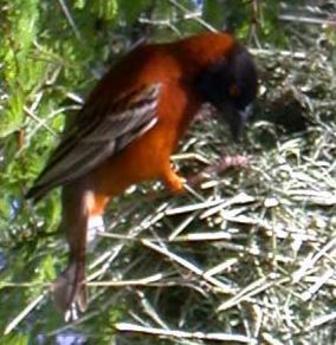Chestnut Weaver

Original source: Ploceus-rubiginosus-2.jpg
Author: Ploceus-rubiginosus-2.jpg : Bries
The Chestnut Weaver is classified as Least Concern. Does not qualify for a more at risk category. Widespread and abundant taxa are included in this category.
Chestnut Weaver | Martin 2007» thumbnail | full | big_thumbnail | printer friendly version Post new comment - Your name: * E-mail: *The content of this field is kept private and will not be shown publicly. More
Chestnut Weaver | Martin 2007» add new comment Syndicate content what is birdman seeing? - Twitter Updates - follow me on Twitter topics - Birding Ecological Survival migration Climate wintering birds ITCZ Larks Site reports Decline of Gyps Vultures Raptors Safari Wildlife Gardening places - Mount Meru Lake Naivasha Lark Plains Oldonyo More
other birds except the Chestnut Weaver, which is substantially larger and has white on its wings. The breeding male's legs and feet are horn (pale grey) in colour. The non-breeding male Chestnut Sparrow has white flecking on the upperparts, and much of its plumage is buff or whitish with chestnut crescent markings, until the bright chestnut of the breeding plumage is exposed by wear. More
The Chestnut Weaver (Ploceus rubiginosus) is a species of bird in the Ploceidae family. It is found in Angola, Botswana, Eritrea, Ethiopia, Kenya, Namibia, Somalia, Sudan, Tanzania, and Uganda. Search Wikimedia Commons Wikimedia Commons has media related to: Ploceus rubiginosus References - * BirdLife International 2004. Ploceus rubiginosus. 2006 IUCN Red List of Threatened Species. Downloaded on 26 July 2007. More
Habitat: The Chestnut Weaver is mainly found in light and densely wooded forests, where there are Mopane trees. It also likes open areas, such as open woodlands, and even found close to human habitations. General habits: It is a social bird usually seen in small family groups or in large flocks of several hundred individuals. Feeding habits: The Chestnut Weaver forages mostly on the ground. More

Original source: Gavin Goodhart
Author: Gavin Goodhart
Permission: Some rights reserved
Family : Ploceidae
Genus : Ploceus
Species : rubiginosus
Authority : Rüppell, 1840
